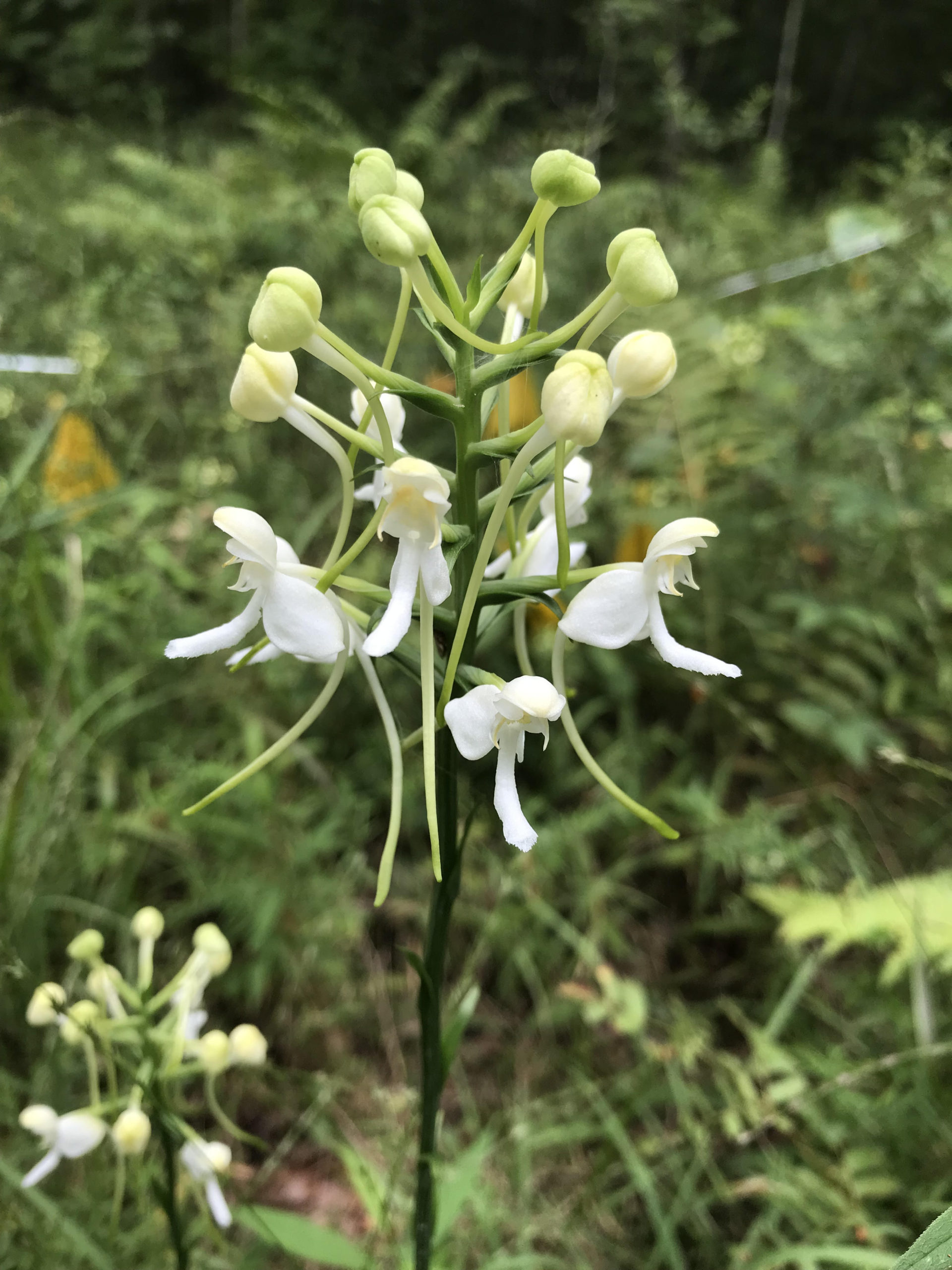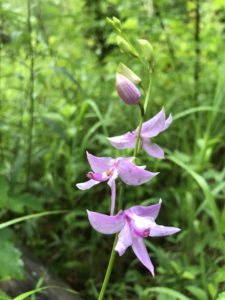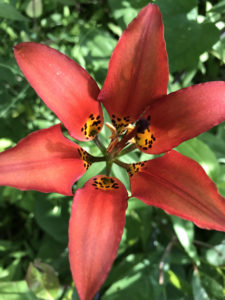
By: Heidi Braunreiter
The Office of Kentucky Nature Preserves (KNP) is currently working on a restoration project in southern Cumberland Plateau of Kentucky. The preserve in which the project is located is home to one of the largest populations of the federally threatened white-fringeless orchid (Platanthera integrilabia) in Kentucky. This elusive orchid, also known as monkey-faced orchid, is a beautiful two-foot tall plant with white flowers blooming in late summer. Over a decade ago, the restoration project was initiated to boost population numbers of the orchid as it was experiencing detrimental population losses. As the project progressed, it transitioned into the restoration of the entire plant community, a Cumberland Plateau acid seep, in which the white-fringeless orchid grows.
A Cumberland Plateau acid seep in itself is a rarity across Kentucky’s landscape. These acid seeps occur in the headwaters of streams in eastern Kentucky on the Cumberland Plateau. They are transient wetland communities that change over time through the creation of canopy gaps in a forest and the subsequent closing in of the canopy. Historically, these canopy gaps were thought to be the result of natural old-growth tree falls, megafaunal disturbance, flooding and periodic fires. The canopy gaps created from the natural tree falls resulted in a depression in the soil and an increase in solar exposure to the ground. Flooding events would fill in the depression with water and a different suite of plant species were able to come in and thrive. Periodic fire and animal browsing helped to maintain these wetlands as open by keeping woody plants from growing and re-closing the canopy.

As a direct result of logging and fire suppression, acid seeps disappeared from the landscape. The remaining pockets of these communities in Kentucky are often associated with rare plants as the suite of species that grow there can be limited to this unique habitat type. Habitat loss is the biggest threat to the white-fringeless orchid. Other plants associated with acid seeps include white turtlehead (Chelone glabra), red chokeberry (Aronia arbutifolia), grass pink (Calopogon tuberosus), sedges (Carex spp.), regal fern (Osmunda regalis), cinnamon fern (Osmundastrum cinnamomea), club-spur orchid (Platanthera clavellata), yellow-fringed orchid (P. ciliaris), crested yellow orchid (P. cristata), peat moss (Sphagnum spp.), and netted chainfern (Woodwardia areolata).
The ideal habitat for white-fringeless orchid is not entirely known to scientists as there are many factors involved (hydrology, solar exposure, pollinators, plant associates, etc.). For the past 13 years, KNP botanist Tara Littlefield has been collecting data on this population of white-fringeless orchid to track the progress of the restoration project, as well as glean information about what makes an ideal white-fringeless orchid habitat. This research has led to a better understanding of the seep hydrology, orchid population trends, as well as pollinator dynamics.
KNP determined the best method to save the white-fringeless orchids was to recreate its ideal habitat. To restore the acid seeps, KNP land managers have maintained them in a static state of open canopy rather than letting the canopy naturally close over time. They have maintained the seeps in this way by thinning the canopy and understory through intensive manual removal of woody and invasive species from the interior and fringes of the seeps. In the coming years, prescribed fire will also be utilized once the effects of the fire on the orchid are better understood. These methods have allowed KNP to achieve their goal of increasing the orchid population numbers.
Now that the Cumberland Plateau acid seeps are in better conditions, KNP’s restoration project has once again evolved and expanded to include the uplands adjacent to the seeps. These uplands are heavily forested with low plant diversity and the management goal is to restore them to Cumberland Plateau pine-oak barrens, another rare plant community in decline in eastern Kentucky. Pine Barrens are open woodlands made up of a mix of sandstone outcrops, grasslands, and open pine-oak woodlands with an open understory.

Historically, pine barrens were maintained by periodic fire keeping the understory and canopy open. Due to logging and fire suppression, this community is greatly reduced and altered in Kentucky. The majority of the remnant pine barrens in Kentucky are restricted to powerline corridors and roadsides in the Daniel Boone National Forest (DBNF). Consequently, many of the plants once associated with this plant community are also rare. Wood lily (Lilium philadelphicum) for example, is restricted to this habitat in Kentucky and can be found primarily on roadsides of the DBNF. Population numbers of wood lily have plummeted in recent decades. Numerous other plants of concern also depend on this habitat including Ten-lobed False Foxglove (Agalinis decemloba), Yellow Wild Indigo (Baptisia tinctoria), Bearded Skeleton-grass (Gymnopogon ambiguous), Southern Crabapple (Malus angustifolia), Appalachian sandwort (Minuartia glabra), Racemed Milkwort (Polygala polygama), Hairy Snoutbean (Rhynchosia tomentosa), Chaffseed (Schwalbea americana), Eastern Silvery Aster (Symphyotrichum concolor), and Roundleaf Flameflower (Talinum teretifolium).
Currently, KNP land managers are restoring the uplands to pine barrens by thinning out softwood trees, such as black gum and maple, and leaving hardwood trees, such as shortleaf pine and oaks. They have left a buffer of forests around the white-fringeless orchid seeps until there is a better understanding of how the orchids will react to periodic fire. Prescribed fire will be utilized in coming years to maintain the woodlands in an open state and help rejuvenate the grasslands. Josh Lillpop, KNP Natural Areas Branch Manager, said of the project, “so much of what we are trying to do right now is related to increasing the sunlight on the forest floor. We have already seen some interesting things showing up where canopy gaps have been created.” In the future, they may be able to reintroduce some of the rare plants, such as wood lily, to these pine barrens where they can thrive.
KNP’s restoration project has changed from a single species focus to overhauling an entire ecosystem in eastern Kentucky. Littlefield said of the project, “it’s important to protect this federally threatened plant, but it also led us down this path of restoring all of these rare communities that are interconnected in the Cumberland Plateau. We’re hoping to eventually connect the pine barrens project to the white fringeless orchid seep project, to restore these lost ecosystems, and to study the dynamics of disturbance effects and ecology not only on a single species level, but within and between these rare community types that exist across the natural landscape”
